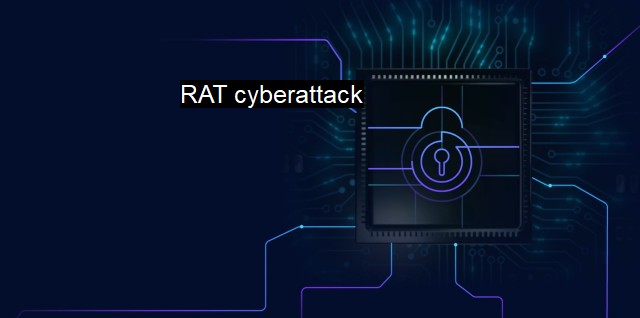What is RAT cyberattack?
Understanding and Protecting Against the RAT Cyberattack: The Risks, Operations, and Countermeasures
RAT stands for Remote Access Trojan, a type of malware that provides cybercriminals with access to infected devices through a backdoor, bypassing the usual authentication methods to maintain stealth. The term RAT cyberattack pertains to attacks remotely conducted by unauthorized individuals or entities using RATs to compromise computers or networks.RATs are insidious since they hide behind everyday, legitimate-looking software downloads or suspicious email attachments. These Trojans are difficult to detect because they mimic or impersonate approved activities to remain invisible to standard antivirus solutions. Still, these discrete operations can carry out harmful activities like the theft of sensitive data, deleting files, or updating the malware to increase its resilience against detection and removal attempts, essentially running amok inside the system undetected.
The capability of RATs to seize control over a device is their most striking working mechanism - technically an 'across-the-board access.' This mode starts from manipulating system settings to conducting complex operations, transitioning from simple inspector roles to controller roles without the user's knowledge. several high-end RATs will allow attackers to do just about anything they wish, such as track keystrokes, manipulate ongoing processes and hardware like activating a webcam or recording audio, enable system shutdowns, and siphon off confidential data.
The real threat harkens back to the term “remote.” The RATs enable cybercriminals to control devices from any global location, making tracking and prosecution virtually impossible. an attacker can infect numerous devices at once, gathering an entire network of zombies or a botnet to instigate large-scale attacks such as Distributed Denial of Service (DDoS) attacks.
In the landscape of cybersecurity and antivirus solutions, understanding RAT cyberattacks is instrumental. To mitigate the risks, powerful and advanced antivirus and an intrusion detection system are essential. Equipped with behavioral detection functionalities, such cybersecurity tools can sniff out most RATs, blocking them before establishing connections with the traffic command and control servers.
Encryption software also plays a key role. The primary function of encryption is to encode data so that only authorized parties can access or modify it. Hence, even if a RAT infiltrates the encrypted information, the unauthorized entity remains unable to decipher the data.
Regular system, application, and security updates are necessary. Developers continuously improve security protocols, provide patches for known flaws or vulnerabilities in regular updates, a vital protective layer against impending RAT attacks.
Firewalls are effective barriers against incoming network traffic, shutting out potential RATs. Firewalls scrutinize every traffic bit and block suspicious, unwanted connections, thus adding another layer to the antivirus's existing capabilities.
Users' awareness and responsible online behavior also contribute significantly to curbing RAT cyberattacks. Practicing caution when downloading files from untrusted sources, staying away from dubious emails, or not visiting questionable websites can help avoid RAT attacks.
Although suitable backup measures aren't a preventive method per se, they have an essential role as safeguards if a system compromise has already happened. They may not stop RATs from getting into the system, but they do enable users to restore sensitive information if necessary, reiterating the common axiom in cybersecurity: "It's not about if a breach will happen, but when."
RATs profoundly challenge our current understanding of cybersecurity and should serve as a stern reminder of continuously ramping up our digital fortification measures. With the evolution of technology evolving cyber threats, we cannot afford to stagnate our cybersecurity approaches, especially given the increasing occurrence and sophistication of RAT cyberattacks.

RAT cyberattack FAQs
What is a rat cyberattack?
A RAT (Remote Access Trojan) cyberattack is a type of malware that allows hackers to gain unauthorized access to a computer or network from a remote location. The attacker can then steal data, install additional malware, or disrupt the system.How to protect my system from rat cyberattacks?
To protect your system from RAT cyberattacks, you can take several steps, such as using antivirus software, keeping your system and software up-to-date, using strong passwords, and avoiding suspicious links and downloads. You can also limit access to your system by using firewalls or network segmentation.What are the signs of a rat cyberattack?
The signs of a RAT cyberattack can vary, but some common indicators include slow system performance, unauthorized access to files or accounts, strange network activity or connections, and unexpected pop-up windows or error messages.What should I do if I suspect a rat cyberattack?
If you suspect a RAT cyberattack, you should isolate the affected system from the network, shut down the system if necessary, and report the incident to your IT department or a cybersecurity professional immediately. They can help you remove the malware and investigate any potential damage to the system or data. You should also change all passwords associated with the affected system and monitor your accounts and data for any suspicious activity.| | A | | | B | | | C | | | D | | | E | | | F | | | G | | | H | | | I | | | J | | | K | | | L | | | M | |
| | N | | | O | | | P | | | Q | | | R | | | S | | | T | | | U | | | V | | | W | | | X | | | Y | | | Z | |
| | 1 | | | 2 | | | 3 | | | 4 | | | 7 | | | 8 | | |||||||